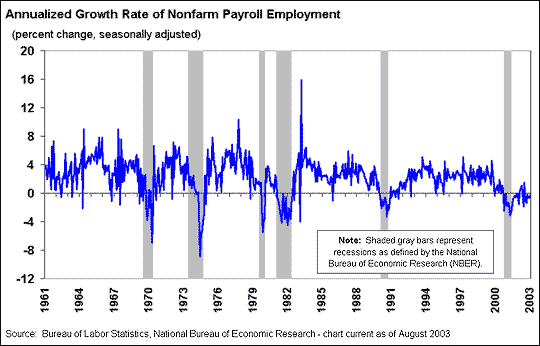Despite boasts during the boom years of the late 1990s about taming business cycle downturns, the U.S. economy slumped into a recession that lasted from March 2001 until November 2001. This recession ended a ten-year period of expansion in the national economy, the longest expansion in U.S. history according to the National Bureau of Economic Research (NBER).
Official business cycle dates—the peaks and troughs in the economy that define recessions and expansions—in the U.S. are determined by the NBER. A private, nonprofit, nonpartisan research organization founded in 1920, the NBER is dedicated to understanding how the economy works. Today it has over 600 university professors and researchers who conduct empirical research on the economy as Bureau associates.
Business Cycles
Within the NBER, the Business Cycle Dating Committee plays the key role in determining business cycle dates. The committee is comprised of a small group of leading business cycle experts. This group reviews a variety of economic statistics and indicators of U.S. economic conditions before deciding on the turning points in the economy—business cycle peaks and troughs—that define periods of recessions and expansions. A list of U.S. business cycles dating back to the mid-1800s is available on the NBER web site.
Official Recessions and Expansions
The NBER web site describes a recession and the types of economy-wide economic data used to identify a recession in the U.S. economy as follows:
A recession is a significant decline in activity spread across the economy, lasting more than a few months, visible in industrial production, employment, real income, and wholesale-retail trade. A recession begins just after the economy reaches a peak of activity and ends as the economy reaches its trough. Between trough and peak, the economy is in an expansion. Expansion is the normal state of the economy; most recessions are brief and they have been rare in recent decades.
Because a recession influences the economy broadly and is not confined to one sector, the committee emphasizes economy-wide measures of economic activity. The traditional role of the committee is to maintain a monthly chronology, so the committee refers almost exclusively to monthly indicators. The committee gives relatively little weight to real GDP because it is only measured quarterly and it is subject to continuing, large revisions.
The broadest monthly indicator is employment in the entire economy. The committee generally also studies another monthly indicator of economy-wide activity, personal income less transfer payments, in real terms, adjusted for price changes. In addition, the committee refers to two indicators with coverage of manufacturing and goods: (1) the volume of sales of the manufacturing and trade sectors stated in real terms, adjusted for price changes, and (2) industrial production.
Graphical Illustration
The chart below shows the behavior over the business cycle of the monthly annualized growth rate for seasonally adjusted payroll employment. The gray bars represent periods of recession defined by the NBER—payroll employment growth is typically negative during recessions.
 |
It Takes Time to Make the Call
The Business Cycle Dating Committee typically waits to get revised data and have a more complete picture of economic conditions before deciding on the peaks and troughs of the business cycle. For example, the committee did not announce the March 2001 peak and the onset of the recession until November 26, 2001. It also is important to wait long enough to identify the trough in the economy that signifies the beginning of an expansion. The committee did not announce their determination that the 2001 recession ended in November until July 17, 2003. The committee noted that, “The 2001 recession thus lasted eight months, which is slightly less than the average duration of recessions since World War II. The postwar average, excluding the 2001 recession, is eleven months.”
Calling the 2001 Downturn and Examining Growth in the Post-Bubble Economy
For further reading on the subject Dr. Econ recommends the article, “Has a Recession Already Started?” by Glenn D. Rudebusch. This timely FRBSF Economic Letter (2001-29; October 19, 2001) provides an excellent review both of the process used to identify turning points in the business cycle and the behavior of key economic indicators around the business cycle peak in 2001.
Rudebusch also provides a clear discussion of why a recession based on the official business cycle definitions are a more accurate description of a recession than the “commonly used” business cycle description of two quarterly declines in real Gross Domestic Product.
A popular rule of thumb is that two consecutive quarterly declines in real GDP signal a recession. This rule is consistent with the dispersion and duration requirements for a recession and with the average recessionary path of real GDP; however, two very small quarterly declines might not produce the depth required for a recession. Indeed, in dating business cycles, the NBER does not use this rule or focus on movements in quarterly real GDP.
“Growth in the Post-Bubble Economy,” by Kevin J. Lansing, FRBSF Economic Letter (2003-17; June 20, 2003) is another insightful article into the behavior of the economy during the 2001 recession and into current expansion. The article evaluates the business cycle in a historical context and “…helps shed light on the underlying causes of the recession and identifies some fundamental factors that can be expected to influence growth the years ahead.”
References
[URLs accessed August 2003]
National Bureau of Economic Research.
http://www.nber.org.
Lansing, Kevin J. “Growth in the Post-Bubble Economy.” FRBSF Economic Letter 2003-17, Federal Reserve Bank of San Francisco; June 20, 2003.
/publications/economics/letter/2003/el2003-17.html
Rudebusch, Glenn D. “Has a Recession Already Started?” FRBSF Economic Letter 2001-29, Federal Reserve Bank of San Francisco; October 19, 2001. /publications/economics/letter/2001/el2001-29.html